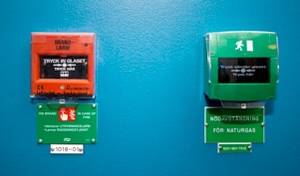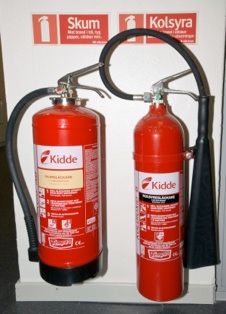4.1 Evacuation and fire
Evacuate the premises when the alarm sounds
The evacuation plan, which is posted in proximity to all stairwells at Kemicentrum, shows the available and alternative evacuation routes and assembly points.
See info regarding evacuations on 9.3 Plan of Action for Emergency Evacuations.
Note! Do not use elevators when evacuating the premises.
Rescue - Sound alarm - Extinguish
Kemicentrum has an automatic fire alarm directly connected to SOS alarm. This alarm is activated by smoke detectors placed in corridors, vestibules, lecture halls, the central library, and in the students’ community rooms.
Smoke detectors are highly sensitive to all types of smoke. A candle or a sparkler can set off the alarm if the smoke detector is situated close by. The alarm can also be activated manually by alarm buttons placed proximity to the evacuation routes. During an evacuation, the alarm bells ring and warning lights flash (where these have been installed).

Sounding the alarm
In case of fire and/or risk of fire, explosion or gas leakage, the Fire Department must be alerted. Dial 112 (if you are calling from an internal phone, dial 0 in order to secure an external line) and request fire department.
Give clear information about:
- Address: Kemicentrum – entrance A - H – floors (-1 – +4)
- What has happened: Fire, gas leakage, etc.
Always meet the fire fighters in order to give them more information and directions. Even if the automatic alarm has been activated, call SOS Alarm/the Fire Department to check that they have received the alarm and to give them further information about the situation.
Fire fighting equipment
Fire hydrants, fire extinguishers, fire blankets and emergency showers, are located in corridors, laboratories, equipment halls, etc.
- Electrical fires: use carbon dioxide extinguishers.
- Solvent fires: use carbon dioxide or foam extinguishers.
In addition to hand-held fire extinguishers, fire hoses for water are located in some corridors.
Note! Access to fire fighting equipment must not be blocked.

Fire extinguishing
For smaller fires use a hand-held extinguisher. Clothing on fire should be dealt with using fire blankets, items of clothing, or an emergency shower. Never use synthetic material to extinguish a fire!
Fire in a laboratory
Rescue, sound alarm and extinguish.
- Evacuate the laboratory at once.
- Evacuate injured individuals.
- Alert the Fire Department
- If the fire is isolated, begin attempts to extinguish the fire if this can be accomplished without risk of personal injury
- If possibly - remove gas tubes and containers of flammable solvents
- Close all doors to the laboratory if the fire proves difficult to extinguish. This reduces the supply of oxygen to the fire.
Evacuation routes
- Evacuation routes may NOT be blocked!
- Flammable materials may NOT be placed in the way of evacuation routes.
- To prevent fire doors from NOT closing when activated, passage ways should remain open and free of obstacles.
Read more: 12. Reassembly points
Fire doors
The fire doors serve to limit the spread of fire and close automatically in case of fire (and fire alarm) this is to prevent personal injury and spreading the fire during evacuations. In Building I and III all fire doors close once a week and must manually be opened the next day.
The fire alarm is tested quaterly. Always evacuate unless you have recieved information from the administrative department and are sure that it is a test.
In Buildings I, II and III: In case of fire, the alarm sounds only on the floor where the fire started, and the fireproof doors close only on the floor where the alarm sounds.
In Building V: In case of fire, the alarm sounds only on the floor where the fire started, but in this building the fireproof doors close on all floors.
